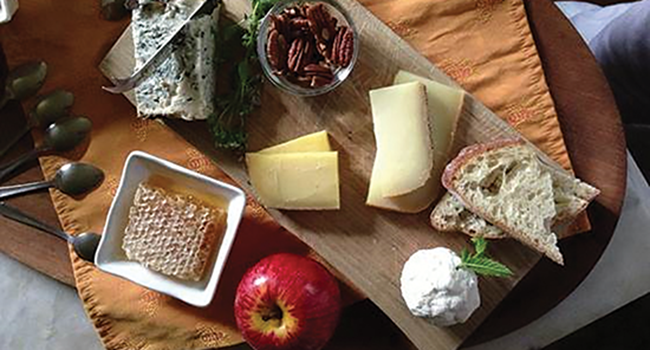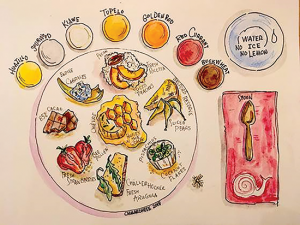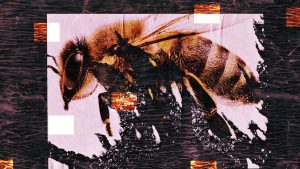By Marina Marchese
Fireworks For Your Mouth.
Move over tea and toast, honey has a new sidekick that will delight your taste buds while engaging your sense of culinary adventure. Have you tried pairing cheese with honey lately?
It’s a marriage made in heaven and if you’re new to this emerging trend, think of it as a fresh spin on your classic breakfast yogurt and honey. Just imagine the soul-satisfying sweetness of honey drizzled over a creamy, salty cheese, now a bite of crusty bread and say a fig or walnut for that extra tactile pleasure. If this sounds divine and ignites your curiosity, let’s explore this mouth-watering duo. As you might expect, there are as many styles and flavors of cheeses to complement every single beekeeper’s honey.
The story of cheese and honey began somewhere around A.D. 14-37 with a Roman gourmand named Marcus Gavius Apicius. Throughout the ages, the name Apicius has been associated with luxury and gluttony and just happens to be the title of the oldest collection of recipes from ancient Rome. Although there are many legends surrounding the life of Apicius, history seems to agree that his extravagant menus were regarded as a high art and his parties were lavish banquets often lasting for days on end. After all, feasting was a significant part of Roman society, and honey was a delicacy reserved for only the elite. Apicius included honey in many of his recipes, it kept food fresh and moist; and could mask the taste of spoilage, a grim reality in the days before refrigeration. Featured in one manuscript titled De Re Coquinaria of Apicius (On the Subject of Cooking) was a pioneering recipe called Mel et Caseus (Honey and Cheese) This simple, yet elegant pairing called for fresh cottage cheese and coriander sprigs drizzled with honey. Another, Libum, resembles our modern-day cheesecake where Apicius instructs us to mix two pounds of crushed cheese and one pound of flour with an egg to form a soft dough. Bake the dough in a heated oven at 425°F for thirty-five minutes until the cake is golden brown. Warm one-half cup of honey in a bowl then place cakes in to soak for half an hour. Researcher and author, Eva Crane mentions Apicius in her book, The World History of Beekeeping and Honey Hunting. She quotes “Honey was used in all sweet dishes, or poured over them after cooking . . .” It appears that Apicius clearly appreciated that the fine flavors of honey are best savored when added as a final touch to dishes, rather than cooked into a recipe.
So how do we begin to choose the best cheese to pair up with honey? It’s simply a matter of mixing and matching smells, taste and textures that please you. We can start by accessing the weight or intensity of the honey you have in hand – concentrate on the smell and flavor, is it light and delicate (sage, black locust or fireweed), midrange (linden, clover or orange blossom), pungent or intense (eucalyptus, buckwheat or oilseed rape). The intensity of the honey is a good starting point to choose the intensity of the cheese for your pairing. I suggest finding a balance where one does not over power the other.
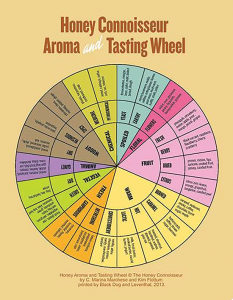 But First, let’s brush up on our honey tasting skills. Taste vs Flavor
But First, let’s brush up on our honey tasting skills. Taste vs Flavor
Taste is one of our basic senses that is defined by sensations the human tongue can experience with food or beverages. The basics are sweet, salty, sour and bitter. Some also include umami, often described as a savory yumminess found in broths, soy sauces, or mushrooms – yes, there are honeys that can be described as having umami, salty, sour or bitter in addition to sweet. Flavors are all those complex notes we experience in our nose while food is in our mouths. Our noses can detect thousands of different flavors and some honeys can be described as having flavor notes of green melon, malt, lilac, gym bag or even dry hay. Understanding taste vs flavor can be somewhat confusing as we are inclined to say something taste good when we are actually talking about flavor. Try eating something with your nose pinched, you cannot taste your food until you unpinch your nose to smell the food. Test your skills for picking out smells and flavors in honey by using the honey aroma and flavor wheel. Begin in the center of the wheel by choosing a general flavor family that your particular honey falls into. Some honeys will fall into two or more flavor families; I consider these complex. Work your way toward the outside of the wheel to hone in on specific flavor notes. The wheel does not provide every flavor you’ll taste in a honey however it is a tool to awaken your taste buds and help find the words to express what you are tasting. Always feel free to use your own descriptors that come to mind when describing a honey. I’ve used descriptors like Grandma’s attic, French perfume or wet wool to describe some honeys I’ve tasted. Each person’s tasting experience is unique and personal, we store them in our brains as flavor memories.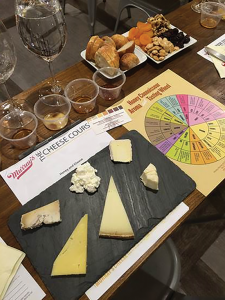
Once you have pinned down the flavors in your honey, it’s time to pick a cheese. I am excited to share with you what I’ve learned about cheese from the cheese mongers at Murray’s Cheese Shop in Manhattan. For those of you who are not familiar with Murray’s, they are regarded as a legend in the world of cheese and everyone who works there is as passionate about cheese as I am about honey. For more than 10 years, I have had the glorious opportunity to work closely with their instructors creating menus for honey and cheese classes at their shop. During our planning sessions, we would taste a wide variety of cheeses and honeys side by side, pick out flavors to procure interesting and educational tasting flights for attendees. Each pairing has featured an interesting combination of colors, aromas, flavors and textural qualities to tickle each taster’s tongue. There are no hard and fast rules to creating a magical combination, however, when it comes to pairing these two, it is all about the sensory experience. Like honey, cheese is a terroir-driven food meaning the variables in its production impart unique sensory qualities to the final product. Applied to cheese we consider the type of animal’s (cow, sheep, goat or buffalo) milk from which the cheese was produced, the pasture that particular animal grazed on including the microclimate, seasonality and cheese maker’s touch that make each cheese unique. We can say the same about honey, the floral sources, the environment, climate, soil including the honey bees’ preferences will impart ever changing sensory qualities. Both products of nature, can be married in various combinations depending upon your preference for color, aroma, flavor and texture. Check out the cheese counter at your local store and ask to taste a few samples. Taste a variety of cheeses – old, new, stinky and blue. If this is not possible, start with what you know or what you like. Taste and the enjoyment of foods are subjective, so experiment to find a combination that is pleasing to your palate. Engaging all your senses makes your pairings and all food more enjoyable.
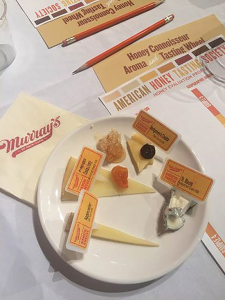 Here are a few tips to get you started pairing honey and cheese . . .
Here are a few tips to get you started pairing honey and cheese . . .
Honey Pairing Tip #1 – Complementary
Pairing honeys with cheeses of equal intensity and flavors creates balance.
Light honeys with light cheese and strong honeys with bold cheeses.
Note: sweet honeys will balance out salty, bitter or acidic cheese.
Pairings to try:
Ricotta cheese with light, delicate honeys.
Blue or stinky cheese with bold, dark honeys with animal or woody notes.
Brie or Gouda with wildflower honeys of medium intensity.
Honey Pairing Tip # 2 – Contrasting
Here we try the reverse theory, opposites attract.
Pair light and sweet honeys with salty or blue cheeses or dark rustic honeys with light, mellow cheeses.
Pairings to try:
Cheddar with a bold honey that has warm or vegetal notes.
Parmigiano-Reggiano or Manchego with a sweet and mellow honey with vegetal or woody notes.
Texture matters: The texture of our food adds to the overall enjoyment and is an important part of the sensory experience.
Who can resist the chewing on honey in the comb or the fine granules of a whipped or crystallized honey? These two are all about the mouthfeel which adds another dimension to the overall tasting experience. Try equally textural cheeses that are gooey, crumbly or firm.
Pairings to try:
Honey in the comb with a triple crème cheese.
Crystallized honey with a crumbly or firm cheese.
Honey Pairing Tip # 4
Local always works: If it grew together it goes together. Your own honey is naturally a perfect complement to the cheeses and foods that were produced in your region. This is the true meaning of terroir or a taste of a particular place.
Honey Pairing Tip # 5
If you like it, then it is delicious! There’s no right or wrong. Start with cheese and honey pairings that you know and like. When in doubt choose a mild, soft cheese like ricotta, yogurt or goat which are light enough to let the honey shine and be the star.
Last thoughts
Honey should complement the cheese so a little goes a long way. Cheese, like honey, is best served at room temperature so remove your cheeses from the fridge 30 minutes before serving.
A variety of flavors and textures keeps it interesting and you may just stumble upon your next cannot – live – without combination. For added textures and flavors serve some roasted or salted nuts like pistachios, walnuts or macadamia. Dried or fresh fruits – anything goes here – so pick your favorites in a range of tart cherries or apricots, fruity dates or raisins or try freshly sliced green apples or figs. Why not include fresh herbs like rosemary or mint to create some drama. Bread or crackers are a necessity as well as wine, beer or mead to wash it down. Choose what you like and experiment often. There are endless choices and combinations so there’s something for everyone. Test your choices on your family and friends by serving a platter of various cheese and honey pairings at your next holiday gathering, I guarantee lively conversation and loads of good cheer for all. I regularly post photos of my honey tastings activities on my personal Instagram and Facebook pages @honeysommelier. Tag me to share your honey pairing creations, when possible, I will share and repost.
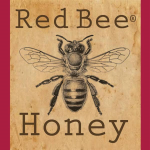 C. Marina Marchese has presented Honey & Cheese classes with Murray’s Cheese Shop, EATALY, the Museum of Food and Drink (MOFAD), ICC in NYC, Vermont Cheese Festival, Hazon Food Conference, Crystal Bridges and Slow Food Nations. She is a member of the Italian National Register of Experts in the Sensory Analysis of Honey, where she received her formal training as a honey sensory expert. For more information and honey pairing ideas, check out her book with Kim Flottum, The Honey Connoisseur: Selecting, Tasting, and Pairing Honey, With a Guide to More Than 30 Varietals.
C. Marina Marchese has presented Honey & Cheese classes with Murray’s Cheese Shop, EATALY, the Museum of Food and Drink (MOFAD), ICC in NYC, Vermont Cheese Festival, Hazon Food Conference, Crystal Bridges and Slow Food Nations. She is a member of the Italian National Register of Experts in the Sensory Analysis of Honey, where she received her formal training as a honey sensory expert. For more information and honey pairing ideas, check out her book with Kim Flottum, The Honey Connoisseur: Selecting, Tasting, and Pairing Honey, With a Guide to More Than 30 Varietals.






